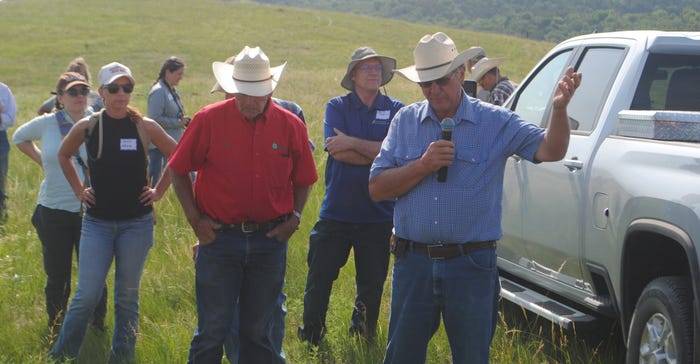
Gene Jessen took over management of his family’s 2,600-acre ranch — located in the rolling, wooded hills along the upper end of Lewis and Clark Lake on the Missouri River in a region known as the Devils Nest — in 1952 after returning home from the military.
In later years, Jessen had operated his land as a ranch, working with his son, Tim, to make the pastures work for rotational grazing and to restore the prairie.
These goals led him to be a pioneer in the use of prescribed fire on his land to rejuvenate native grass and to keep invasive eastern red cedar trees in check. He was burning his pastures before the practice was widely accepted. Over the years, they added cross-fencing, water lines and took aggressive action in clearing out cedar trees.
Father’s legacy
Gene died in 2018, but Tim has been working hard over the past several decades to make strides toward his father’s long-term goals. The Jessen ranch was one of the featured stops on the Nebraska Grazing Lands Coalition (NGLC) summer grazing tour earlier this year.
“I’ve been influenced heavily by my dad and all the work he did in the 1980s and ‘90s,” Tim Jessen told about 200 people on the tour. “Our terrain around here is rough because of the glaciers that formed the ridges and bluffs. That’s why we have a wide variety of soils, with the ridges made up of a lot of sand and gravel.”
Tim Jessen said that the land today looks much better than it did 40 years ago when his father began working on restoring it. The pasture stocking rate in the early days was about 11-12 acres per cow-calf pair. Today, that has gone down to 7-8 acres per pair. They graze between 350-375 pairs through about 20 paddocks, grazing each paddock two to three times a year.
Rotational grazing helped the good warm-season grasses move up the ridges more, Jessen told the tour participants. “It will continue to get better,” he said. “The thing with grasslands is that you can’t fix it overnight. It takes years to get it.”
As far as management of the ranch, there is only one thing that Jessen has changed significantly. “He tried to make one-and-a-half rotations through the pastures with the herd each year,” Jessen said. “We try to get three rotations, and as dry as it has been this spring, we are leaving the cows in pasture about half as long as normal.”
The early drought this spring caused Jessen to move about 350 cow-calf pairs through pasture faster in order to leave more grass to recover. “That keeps the roots from getting burned up with the heat,” he added.
Fire is key
Fire has been a key management tool. “After a prescribed fire, sunlight can get into the gullies,” Jessen said. “That’s where our most fertile soil is. I think what we’ve gained in the last few years in production is mostly in those gullies,” where we gain by getting cool-season grasses and forbs growing.
Jessen acknowledges that the good soil in his gullies probably came from many years ago when the ridges were farmed or overgrazed, and the little topsoil that existed on them washed down into those gullies.
But today, Jessen benefits from those good, fertile gullies once fire has reclaimed them from invasive cedar trees and returned them to hardwood trees and grasslands. “That is money in our pockets because our profit comes off pounds of beef,” Jessen said. “Wildlife like it, too.”
Weed control is always a challenge on rolling pastureland such as on the Jessen ranch. He said that he sprays herbicides on his pastures to control weeds when necessary. He stays away from cottonwood trees when spraying, but hardwood trees withstand herbicide drift better.
“The biggest thing with spraying is that we can get our cool-season grass and forb growing” by killing invasive weeds, Jessen adds.
Watering 350 cow-calf pairs may be one of his biggest challenges over rough grazing land. Tim’s father, Gene, did plenty of spring development over his years of managing the ranch, but springs can’t keep with the water needs of the herd.
In more recent years, Jessen settled on a large holding tank at the top of a ridge to gravity-feed water to stock tanks across his paddocks. He hopes to add more cross-fencing in upcoming years, as well as more water lines to accompany the new paddocks.
For Jessen, his goals for grazing land are carrying on a family tradition begun by his father. “It is an ongoing process,” Jessen said. One of Gene’s favorite sayings, Tim says, was, “If we take care of the grass, the grass takes care of the cows.”
They hope to eventually graze up to 400 cow-calf pairs on the ranch. But use of prescribed fire, keeping weeds down by spraying, along with rotational grazing, have brought his gullies back to life and have rejuvenated his native prairie along the Missouri River.
In addition to the Jessen ranch, the NGLC summer tour also visited the Kalkowski Family Ranches near Lynch, learning about the family’s efforts to improve grazing lands, install watering systems and improve pastures and productivity through rotational grazing.
Learn more about NGLC at nebraskagrazinglands.org.
About the Author(s)
You May Also Like






